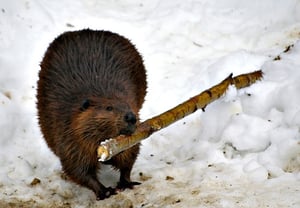 As old man winter begins to loosen his grip on the winter wonderland that we have been playing in for the past 6 months, we notice drastic changes in the landscape happening daily. The white blanket covering the mountains is returning to the familiar brown and green hues that lead us into the vibrant colors of wildflower season. Mud is following us with every footstep we take and the rivers are beginning to pick up steam with increased snowmelt runoff. All of these factors serve as great indicators that summer is right around the corner, and there is an end in sight to the cabin fever that many of us begin to feel towards the end of each winter.
As old man winter begins to loosen his grip on the winter wonderland that we have been playing in for the past 6 months, we notice drastic changes in the landscape happening daily. The white blanket covering the mountains is returning to the familiar brown and green hues that lead us into the vibrant colors of wildflower season. Mud is following us with every footstep we take and the rivers are beginning to pick up steam with increased snowmelt runoff. All of these factors serve as great indicators that summer is right around the corner, and there is an end in sight to the cabin fever that many of us begin to feel towards the end of each winter.
Humans are not the only members of the animal kingdom saying goodbye to cabin fever. Imagine spending your entire winter huddling with your family - mom, dad, brothers and sisters- on a platform in the middle of a pond. Oh and did I mention your mom is pregnant? Ice and snow have covered and insulated your surrounding home made of sticks and mud for months while the pond that surrounds your home is also encased in ice. Your only escape from the lodge is exiting via the underwater doorway and swimming through icy waters to reach your underwater stash of aspens and willows. When you return, you share the food with your family and get back to huddling on the platform to stay warm. After five months of living this way the cabin fever is probably setting in so deep that you are in dire need of a break from the ultimate in family togetherness.
Luckily, this is not the typical over wintering strategy for the majority of human beings, but it is how nature’s architects spend their winters. You can only imagine the relief beavers feel as the temperatures warm and the icy environment begins to melt away. Freedom! Your isolated and sedentary winter lifestyle finally comes to an end and you once again become busy as well, a beaver.
Just as late springtime serves as a time for change for us- skis to bikes and boats, down coats to raincoats, snow boots to sandals- many things begin to move and shake in a beaver colony as well. A typical beaver colony consists of the mom, dad, and two generations of kits. In the spring, the kits that are two years old are essentially forced to move out of the lodge and establish their own territory. This helps ease the pressure on the family’s food supply as the matriarch gears up to give birth to the next generation. So, the beavers are saying goodbye to some family members and hello to new ones.
When the female gives birth to one to four kits around May, everyone in the colony is expected to share in the responsibility for caring for the young. In addition to helping take care of the young, there is also an “all hands on deck” approach to spring cleaning in the lodge. While we air out our homes, mop the muddy floors, and take care of all of those repairs that the persistent snowpack prevented us from getting to all winter, beavers are also taking care of business around their homes.
Spring runoff presents a bit of a challenge for beavers. The faster and more powerful flow of springtime mountain streams can cause structural damage to the beaver lodge and dam. The sound of running water stimulates an internal response in beavers. When they hear that sound, they immediately begin investigating their structure for leaks and breaches that may have occurred. If any damage is discovered, beavers will use any of their winter food cache leftovers along with mud to repair their lodges and dams. After repairing holes, replacing damaged logs, and ensuring their habitat is once again fortified, their work is not yet over.
Each season, beavers must re-establish their territory, which is done with extensive scent mounding. Every beaver has a unique scent called castoreum, which is an oily secretion. The colony members perfume the mud and vegetation surrounding their lodge with their scents. These scent mounds serve as sign posts for dispersing animals. If there was a loss of a matriarch or patriarch over the winter, the scent may indicate that there is a vacancy in the lodge. If not, it is a clear warning to visitors that it is an active colony and the visitor should steer clear of that territory.
Even when these tasks are checked off the to do list, life as a beaver remains busy throughout the summer and fall as these diligent mammals prepare to settle back in to life under the ice. So, as the snow clears from the trails and you transition into the summertime sports of hiking, biking, and paddling, be on the lookout for beavers breaking through their cabin fever and making a splash as they once again regain their title of nature’s busiest creature.
Beth Garrison is the Curriculum Specialist at Walking Mountains Science Center. When she is not writing Curious Nature Columns, she can be found playing outside in the snow and mud and enjoying free live music as she anxiously awaits the arrival of summer.









